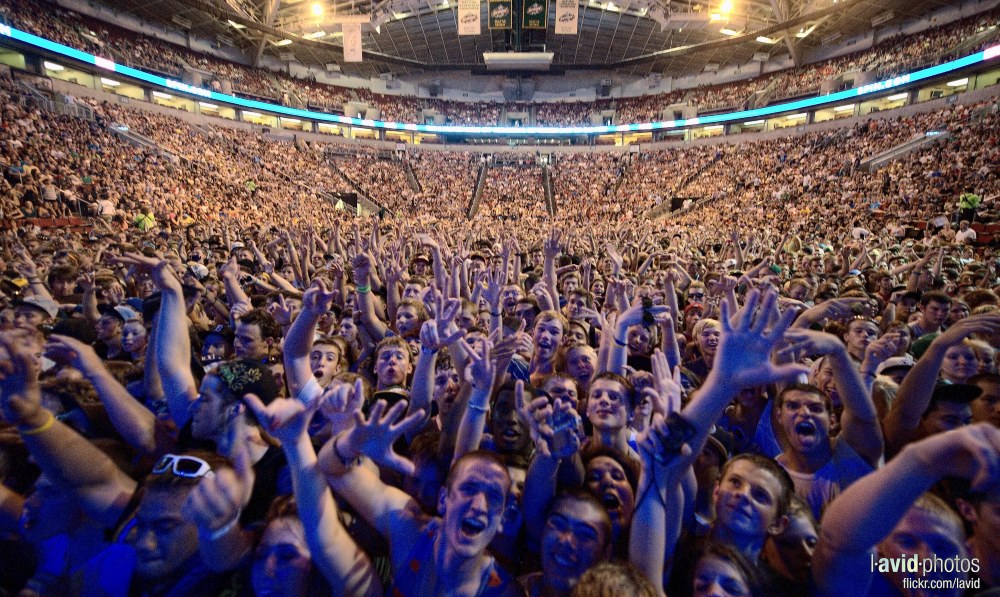
There’s sad news for fans of Bumbershoot. The city’s annual festival, deferred last year because of covid-19, will not return in 2021. This year would have marked the beloved music and arts festival’s 50th anniversary. Instead, owing to continuing virus concerns and insufficient lead time, Bumbershoot has been postponed until 2022.
It’s bitter news; Bumbershoot is one thing that says Seattle like nothing else. The festival, which enlivened late summer weekends for 48 years, was born when Mayor Wes Uhlman saw what Mayor John Lindsay had concocted in New York City.

Although Uhlman took inspiration from Lindsay’s arts festival, he immediately made it Seattle-centric. With a meager city budget, the event debuted August 13-15, 1971 as “Festival ’71.” It featured three days of homegrown talent: stilt-walkers, bands, buskers, film screening and free admission. Despite minimal publicity, the festival drew 120,000 to Seattle Center.
Two years later, organizers decided the festival deserved a better name, settling on Bumbershoot, the quaint British term for an umbrella. It aimed to be an umbrella for the arts. Early festivals, mostly held in the chancy weather of Labor Day weekend, drew crowds — as many as 250,000 — to enjoy performers such as Emmylou Harris, Etta James, and Chuck Berry. It morphed from a free event, funded by the city and corporate sponsors, into a livelier production with modest admission prices — $2.50 a day at first.
Early-day organizers, civic volunteers like Anne Focke and C. David Hughbanks, handed over production to Norm Langill’s One Reel, the home-grown vaudeville company. One Reel became a nonprofit and survived a takeover attempt in the 1980s {Bumbershoot life wasn’t always smooth). Rains came some years dampening attendance. In 1985, a stunt went awry setting fire to the Horiuchi Mural stage. A subsequent riot drew police with batons.
The ‘90s brought ever-higher ticket prices and a dispute over identity. Was Bumbershoot paying too much attention to Boomers’ tastes with acts like Tony Bennett and B.B. King, rather than young home-grown bands? Revival years followed after the Experience Music Project opened in 2000. But then came slumping attendance and One Reel’s chronic financial struggles.
The festival’s pivotal year came in 2014 when One Reel ended up $900,000 in debt and stage hands and others still unpaid. Was it the end for Bumbershoot?
At this point, I have to make a confession. In 2014, I was serving a third term on the City Council and my committee (Parks and Recreation) had oversight of Seattle Center, Bumbershoot’s perennial venue. It was up to the city, owner of the Bumbershoot name, to somehow cover the shortfall and resolve on next steps. Some said the festival should simply be retired; it was a drain on scarce city finances and no longer a novelty among music festivals. Others said it would be a crime not to continue the long Bumbershoot tradition.
Anxious not to be the giant killer, my committee members and I agreed to listen to some possible alternatives. Among them was a proposal from AEG (Anschutz Entertainment Group), the world’s second-largest promoter of live events. It was thought that the Denver-based group would be better able to attract top talent. The plan was to give AEG a five-year contract to work in cooperation with One Reel. In return AEG would pay off Bumbershoot’s debt. The agreement was finally approved and signed in 2015.
Subsequently AEG made key changes, leaning heavily on music acts and working to draw young people rather than appealing to an all-ages crowd. All but forgotten by AEG was an emphasis on other arts — theater and visual. Meanwhile, weather problems cut into Bumbershoot’s turnout, as did the steeper admission prices needed to pay for expensive headliners.

AEG’s five-year stewardship — something many of us came to regret — has now expired without renewal. But the question of Bumbershoot’s future remains. One Reel’s Marty Griswold and Seattle Center Director Robert Nellams agree that what’s needed is a return to the festival’s roots. They wish tickets to be affordable and content drawing all ages and interests.
In typical Seattle style, the pathway ahead has been handed over to a committee. The group now forming includes Nellams; Marc Jones, Seattle Center’s director of marketing and business; One Reel; and members of Seattle Center’s Advisory commission. They’ll explore how the festival will look and who will run it. We’re back at the drawing board.
Nellams and Griswold alike speak of their love for “the mother of festivals,” and their enthusiasm for planning the event’s future. It’s undeniable that Bumbershoot evokes fond memories. One for me is 1989, when the festival was managed by Barbara Earl Thomas, an inspired local artist who used big headliners to draw audiences that could, at the same time, enjoy local artists and performances.
Since the early days, there have been many great Bumbershoot performances: among them Tina Turner, Diane Schurr, Heart, Soundgarden, Loretta Lynn, Sir Mix-a-lot, Bob Dylan, and Macklemore. One year — maybe in the mid ‘90s — festival goers learned to do the Macarena and, one and all, we danced out the door, into the night, and circled the Fountain.
Discover more from Post Alley
Subscribe to get the latest posts sent to your email.

Some suggestions:
Avoid Labor Day weekend (too chancy weather)
Multiple venues, not just Seattle Center (Marymoor, Magnuson Park, new Waterfront Park)
Regional scope, which helps to bring in the countywide tax base (only one funding the arts)
One major corporation, such as Costco or Expedia, becomes the very generous lead sponsor